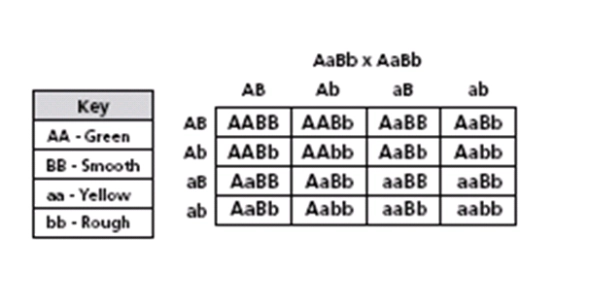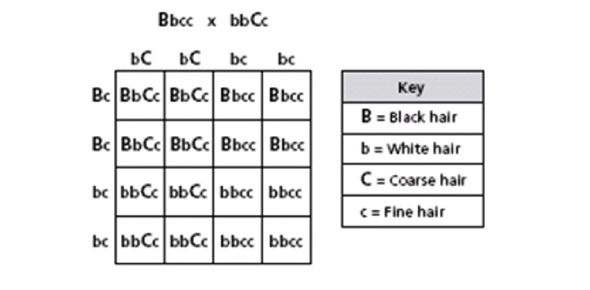Biology: Genetics And Punnett Squares Quiz!

Test your knowledge of Genetics and Punnett Squares with this engaging quiz! Explore the fascinating world of heredity as you answer multiple-choice questions. Discover the basic unit of heredity and learn about different versions of genes. Find out how Punnett squares are used to predict genetic outcomes and analyze inheritance patterns. Explore concepts like homozygosity, heterozygosity, and the Law of Segregation. Dive into genetic disorders caused by mutations in specific chromosomes and understand the genotypic ratios resulting from different crosses. Challenge yourself and see how well you grasp the fundamental principles of genetics. Get ready to unravel the secrets of Read moreinheritance and put your biology knowledge to the test!
- 1.
A heterozygous tall (Tt) plant is crossed at with a short plant (tt). The probability that offspring plants will be tall is:
- A.
25%
- B.
50%
- C.
75%
- D.
100%
Correct Answer
B. 50%Explanation
When a heterozygous tall plant (Tt) is crossed with a short plant (tt), the offspring plants will have a 50% probability of being tall. This is because the heterozygous tall plant has one dominant allele (T) for tallness and one recessive allele (t) for shortness. When crossed with a short plant that has two recessive alleles (tt), there is a 50% chance that the offspring will inherit the dominant allele from the heterozygous parent and be tall.Rate this question:
-
- 2.
What is the term used to describe different versions of the same gene?
- A.
Allele
- B.
Mutation
- C.
Locus
- D.
Genotype
Correct Answer
A. AlleleExplanation
Allele is the correct answer because it refers to the different versions or forms of a gene that exist within a population. Each allele can produce a different trait or characteristic, and individuals inherit two alleles for each gene, one from each parent. These alleles can be the same (homozygous) or different (heterozygous), and they contribute to the genetic diversity and variation observed in a population.Rate this question:
-
- 3.
Which of the following is the basic unit of heredity?
- A.
Nucleotide
- B.
Protein
- C.
Chromosome
- D.
Gene
Correct Answer
A. NucleotideExplanation
A nucleotide is the basic unit of heredity. It is a building block of DNA and RNA, which carry genetic information. Nucleotides consist of a sugar molecule, a phosphate group, and a nitrogenous base. They form the backbone of DNA and RNA strands and encode the genetic instructions necessary for the development and functioning of living organisms. Proteins, chromosomes, and genes are all important components of heredity, but the nucleotide is the fundamental unit that carries and transmits genetic information.Rate this question:
-
- 4.
Organisms that have two different alleles for a particular trait are said to be:
- A.
Hybrid
- B.
Homozygous
- C.
Heterozygous
- D.
Dominant
Correct Answer
C. HeterozygousExplanation
Organisms that have two different alleles for a particular trait are said to be heterozygous. Heterozygous individuals have two different versions of a gene, or alleles, for a specific trait. This means that they inherited one allele from each parent. In contrast, homozygous individuals have two identical alleles for a trait, while hybrids are the offspring of two different species or varieties. Dominant refers to an allele that is expressed over another allele in heterozygous individuals.Rate this question:
-
- 5.
According to the dihybrid cross below, what proportion of peas would be green and smooth?
- A.
9/16
- B.
1/4
- C.
3/8
- D.
1/16
Correct Answer
A. 9/16Explanation
In a dihybrid cross, two different traits are considered simultaneously. In this case, the proportion of peas that are green and smooth can be determined by multiplying the individual probabilities of each trait. Since each trait is controlled by a separate gene, they segregate independently. The probability of a pea being green is 3/4, and the probability of it being smooth is also 3/4. Therefore, the proportion of peas that are green and smooth is (3/4) * (3/4) = 9/16.Rate this question:
-
- 6.
What is the probability that a hamster will have black, fine hair?
- A.
2/16 (1/8)
- B.
4/16 (1/4)
- C.
1/16
- D.
8/16 (1/2)
Correct Answer
B. 4/16 (1/4)Explanation
The probability of a hamster having black, fine hair is 4/16 or 1/4. This means that out of the total possible outcomes, 4 of them have black, fine hair.Rate this question:
-
- 7.
In a cross between two heterozygous individuals (Aa), what is the probability of an offspring having the dominant phenotype?
- A.
25%
- B.
50%
- C.
75%
- D.
100%
Correct Answer
C. 75%Explanation
When two heterozygous individuals (Aa) are crossed, the possible genotypes of the offspring are AA, Aa, and aa. The dominant phenotype is expressed in individuals with either the AA or Aa genotype. Therefore, the probability of an offspring having the dominant phenotype is 3 out of 4, or 75%.Rate this question:
-
- 8.
In pepper plants, the allele for hot flavor (H) is dominant to the allele for mild flavor (h). A farmer crosses a homozygous dominant plant with a recessive (mild) plant. What percentage of the offspring from this cross will have hot flavor?
- A.
25%
- B.
50%
- C.
75%
- D.
100%
Correct Answer
D. 100%Explanation
When the allele for hot flavor (H) is dominant over the allele for mild flavor (h), crossing a homozygous dominant plant (HH) with a recessive (mild) plant (hh) will result in all offspring having hot flavor. This is because the dominant allele (H) will always be expressed in the presence of the recessive allele (h). Therefore, the percentage of offspring with hot flavor is 100%.Rate this question:
-
- 9.
What are the four main bases of D.N.A.?
- A.
Alleles, bacteria, D.N.A., and sunlight.
- B.
Adenine, guanine, cytosine, and thymine.
- C.
Oil, chinchilla, albino, and cement.
- D.
Bristles, onions, grease, and tar.
Correct Answer
B. Adenine, guanine, cytosine, and thymine.Explanation
The correct answer is Adenine, guanine, cytosine, and thymine. These four bases are the building blocks of DNA. They are nitrogenous bases that pair up with each other to form the double helix structure of DNA. Adenine pairs with thymine, and guanine pairs with cytosine. These base pairs are essential for DNA replication and genetic information storage and transmission.Rate this question:
-
- 10.
White fur(b) in guinea pigs is dominated by black fur(B). What will be the probability of a hybrid offspring in the cross: BB x Bb?
- A.
0%
- B.
25%
- C.
50%
- D.
100%
Correct Answer
C. 50%Explanation
In this question, the cross is between a guinea pig with two dominant black fur alleles (BB) and a guinea pig with one dominant black fur allele and one recessive white fur allele (Bb). The dominant black fur allele (B) will always be expressed over the recessive white fur allele (b). Therefore, all of the offspring will have black fur. Since half of the offspring will inherit the dominant black fur allele (B) from the BB parent and the other half will inherit the dominant black fur allele (B) from the Bb parent, the probability of a hybrid offspring in this cross is 50%.Rate this question:
-
Quiz Review Timeline +
Our quizzes are rigorously reviewed, monitored and continuously updated by our expert board to maintain accuracy, relevance, and timeliness.
-
Current Version
-
Dec 13, 2024Quiz Edited by
ProProfs Editorial Team
Expert Reviewed by
Lindsey Block -
Apr 14, 2009Quiz Created by
Raleighegypt
 Back to top
Back to top




